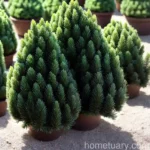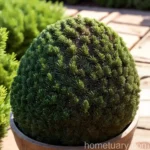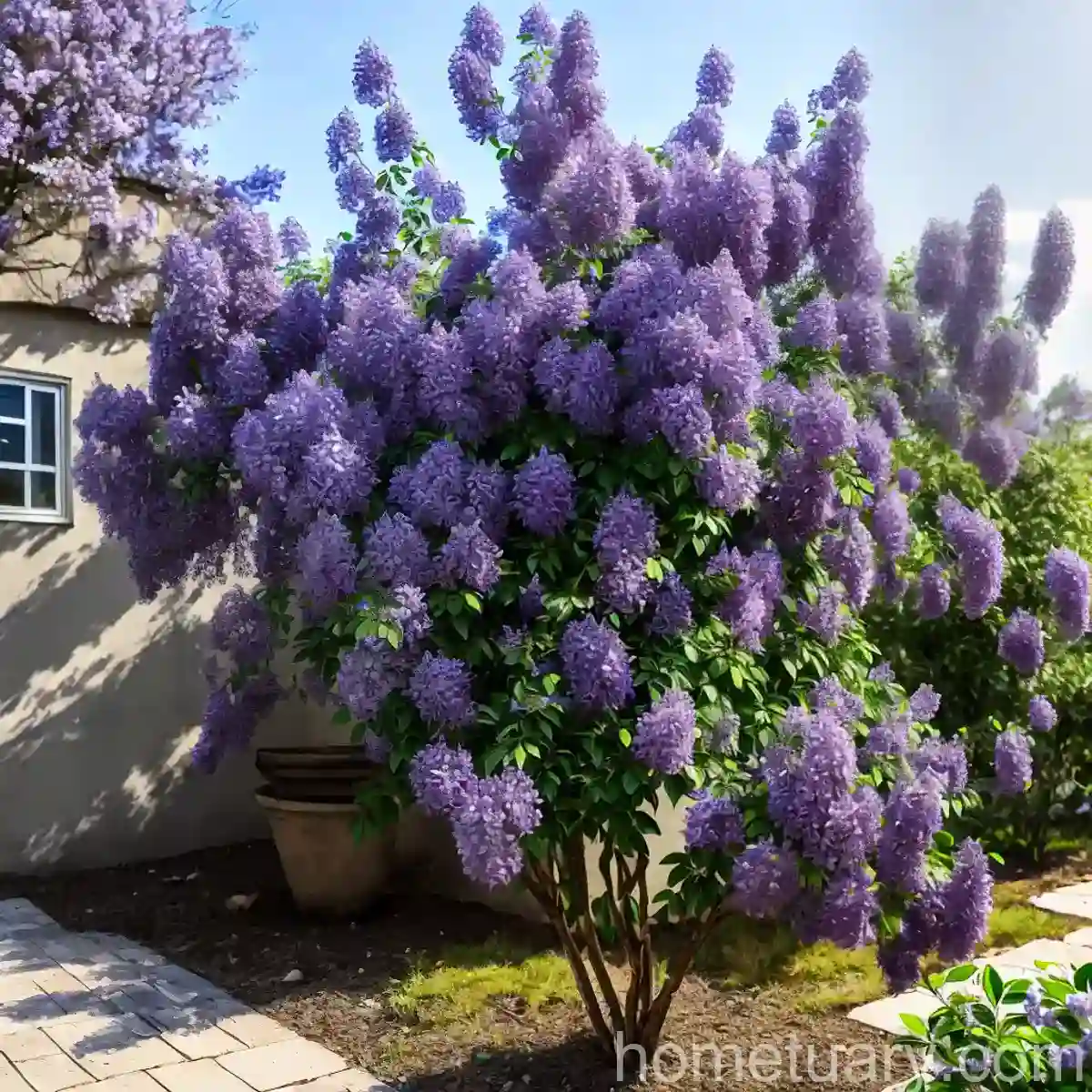Colorado Spruce (Picea pungens ‘Montgomery’): A Guide to Cultivation, Care, and Maintenance
Picea pungens, commonly known as Colorado spruce or blue spruce, is a magnificent evergreen tree that adds charm and beauty to landscapes. ‘Montgomery’ is a popular cultivar of Picea pungens, prized for its striking blue foliage and elegant form. In this comprehensive guide, we will explore the various facets of ‘Montgomery’ – from its culture and uses to care and maintenance, including water, sunlight, fertilizer, soil, pruning, propagation, container planting, common diseases, and pest control. Additionally, we will delve into botanist’s tips, fun facts, and provide useful links to external resources for further exploration.
What is Colorado Spruce (Picea pungens ‘Montgomery’)?
Introduction
Picea pungens ‘Montgomery’, a cultivar of Colorado spruce, belongs to the Pinaceae family and is characterized by its attractive bluish-grey to silver-blue needles with a dense pyramidal shape when young, which later matures into a more upright form. The ‘Montgomery’ cultivar typically grows slower than the species, making it an ideal choice for small gardens, urban plantings, and as an accent tree.
Taxonomy
- Scientific Name: Picea pungens ‘Montgomery’
- Common Name: Colorado spruce, Blue spruce, Montgomery spruce
- Family: Pinaceae
- Genus: Picea
- Species: Pungens
- Cultivar: ‘Montgomery’
Origin
The Colorado spruce is native to the southern Rocky Mountains in the United States and specifically to the state of Colorado, from where it derives its name. The ‘Montgomery’ cultivar, like the species, thrives in cold climates and is renowned for its ability to withstand harsh winter conditions.
Morphology
‘Montgomery’ Colorado spruce is a moderately sized evergreen tree, typically reaching heights of 20 to 30 feet with a spread of 10 to 15 feet. The cultivar exhibits a conical or pyramidal form when young, which gradually develops into a more narrowly columnar shape as it matures. The distinctive silvery-blue needles, which provide a striking contrast against the landscape, make it a sought-after ornamental tree.
Key Takeaways – Colorado Spruce (Picea pungens ‘Montgomery’)
- Scientific Name: Picea pungens ‘Montgomery’
- Common Names: Colorado spruce, Blue spruce, Montgomery spruce
- Family: Pinaceae
- Cultivar: ‘Montgomery’
- Growth Habit: Conical when young, transitioning to narrowly columnar with age
- Needle Color: Silvery-blue to bluish-grey
Now that we have familiarized ourselves with the basics of Colorado spruce (Picea pungens ‘Montgomery’), let’s delve deeper into its culture, uses, and care requirements.
Culture of Picea pungens ‘Montgomery’
Cultivating Colorado spruce requires an understanding of its specific cultural needs to ensure its optimal growth and development. Let’s explore the various aspects of its culture, including its uses, water requirements, sunlight preferences, fertilizer needs, soil considerations, pruning techniques, propagation methods, and its popularity as a container plant.
Uses
-
Landscape Ornamental: ‘Montgomery’ Colorado spruce is widely used as an ornamental tree in landscaping due to its attractive silvery-blue needles and distinctive form. It serves as a focal point in gardens, provides screening, and adds visual interest to the overall landscape. Additionally, it can be used as a specimen tree in parks, public spaces, and large estates.
-
Windbreaks and Privacy: Due to its dense foliage and upright growth habit, Colorado spruce, including the ‘Montgomery’ cultivar, is often used to create windbreaks or as a privacy screen, providing shelter from strong winds and creating a sense of seclusion in outdoor spaces.
Water
-
Moisture Requirements: Picea pungens ‘Montgomery’ exhibits moderate water needs and prefers well-drained soils. It is important to monitor soil moisture levels, especially during hot and dry periods, and provide supplemental irrigation when necessary to ensure the tree’s health and vitality.
-
Watering Frequency: Newly planted ‘Montgomery’ Colorado spruce trees should be watered regularly to help establish their root systems. Once established, they generally require watering during extended dry spells or drought conditions.
Sunlight
- Light Requirements: This cultivar thrives in full sun to partial shade, with optimal growth and needle coloration achieved in sites that receive ample sunlight. When planted in partial shade, it is essential to ensure that the tree receives at least 4 to 6 hours of direct sunlight daily to maintain its vigor and coloration.
Fertilizer
-
Nutrient Needs: Colorado spruce, including the ‘Montgomery’ cultivar, benefits from regular fertilization to support its growth and maintain its overall health. A balanced slow-release fertilizer, specifically formulated for evergreen trees, can be applied in spring to provide essential nutrients.
-
Application Method: Fertilizer should be evenly distributed around the tree’s root zone, following manufacturer’s instructions for proper application rates, and watered in thoroughly to facilitate nutrient uptake.
Soil
-
Soil Type: ‘Montgomery’ Colorado spruce thrives in well-drained, slightly acidic to neutral soils. It is adaptable to various soil types, including loamy, sandy, or clay soils, as long as they offer good drainage.
-
pH Preference: Ideally, the soil pH should range between 6.0 to 7.5 for optimal growth and nutrient uptake. Conducting a soil test can help determine the soil’s pH and nutrient levels, allowing for targeted amendments if necessary.
Pruning
-
Pruning Frequency: Routine pruning is generally not required for ‘Montgomery’ Colorado spruce, especially when grown as a specimen tree in landscapes. However, selective pruning to remove dead or diseased branches, improve tree structure, or maintain desired size and form can be performed as needed.
-
Pruning Techniques: When pruning, it is important to use proper pruning tools, such as sharp bypass pruners or loppers, to make clean cuts. Avoid excessive pruning of the leader or central stem, as it may distort the natural form of the tree.
Propagation
- Propagation Methods: ‘Montgomery’ Colorado spruce can be propagated through various methods, including seed propagation, grafting, and cuttings. While seed propagation is possible, it often results in genetic variability, making it less commonly used for preserving the characteristics of specific cultivars. Grafting and cuttings offer more reliable methods for propagating true-to-type ‘Montgomery’ spruce.
Container Popularity
- Container Planting: Due to its compact size and striking appearance, ‘Montgomery’ Colorado spruce is well-suited for container planting in gardens, patios, and urban landscapes. It can be grown in appropriately sized containers filled with well-draining potting mix, providing an eye-catching focal point for outdoor spaces.
Common Diseases and Pest Management
Common Diseases
-
Cytospora Canker (Leucostoma kunzei): Cytospora canker is a common fungal disease that affects various spruce species, including Picea pungens. It typically presents as sunken cankers on the branches or trunk, accompanied by resin exudation and dieback of affected tissues. Pruning out infected branches and promoting overall tree health through proper cultural practices can help manage the spread of this disease.
-
Needle Cast Diseases: Several needle cast fungi, such as Rhizosphaera and Stigmina species, can cause needle discoloration and premature needle drop in Colorado spruce, leading to thinning canopies and reduced vigor. Proper spacing of trees, adequate air circulation, and fungicidal treatments as preventive measures can aid in mitigating needle cast diseases.
-
Root Rot (Phytophthora spp.): Excessive soil moisture, poorly drained conditions, or soil compaction can lead to root rot in Colorado spruce, manifesting as discolored, stunted, or declining foliage. Improving drainage, avoiding overwatering, and maintaining proper soil health are crucial for preventing and managing root rot diseases.
Disease Diagnosis
-
Symptom Recognition: Diagnosis of diseases in ‘Montgomery’ Colorado spruce involves recognizing characteristic symptoms, such as cankers, needle discoloration, dieback, resinous exudation, and poor growth. Careful observation of the tree’s overall health, foliage appearance, and any abnormal growth patterns can aid in identifying potential disease issues.
-
Laboratory Analysis: In cases where the cause of the disease is unclear, obtaining laboratory analysis, including fungal cultures or genetic testing, can provide specific diagnostic information, helping to pinpoint the underlying pathogens and inform targeted management strategies.
Common Pests
-
Spruce Spider Mites (Oligonychus ununguis): Spider mite infestations can lead to stippled foliage, webbing on needles, and reduced photosynthetic capacity in Colorado spruce. Miticides, horticultural oils, and predatory mites can be employed as control measures to manage spider mite populations and protect tree health.
-
Spruce Needleminer (Endothenia albolineana): The larvae of spruce needleminers can cause damage to the needles of spruce trees, including the ‘Montgomery’ cultivar, resulting in browning and distortion of the foliage. Monitoring for early signs of infestation and employing targeted insecticide applications during larval emergence can help mitigate spruce needleminer damage.
-
Scales and Adelgids: Various scale insects and adelgids, such as the Cooley spruce gall adelgid and pine needle scale, can infest Colorado spruce, affecting new growth and overall tree vigor. Horticultural oils, insecticidal soaps, and systemic insecticides are often used to manage these pests and protect tree health.
Botanist’s Tips: Growing and Caring for Colorado Spruce (Picea pungens ‘Montgomery’)
As a plant scientist specializing in ornamental trees, including Picea pungens cultivars, I have compiled a set of expert tips to guide gardeners, landscapers, and enthusiasts in successfully growing and caring for ‘Montgomery’ Colorado spruce. These tips encompass key aspects of cultivation, maintenance, and overall tree health.
Botanist’s Tips
-
Site Selection: Choose a well-drained site with ample sunlight for planting ‘Montgomery’ Colorado spruce, ensuring adequate spacing from other trees and structures to allow for its mature size and form.
-
Soil Preparation: Prior to planting, amend the soil with organic matter and ensure proper drainage to create an optimal growing environment for the tree.
-
Mulching: Apply a layer of organic mulch around the tree’s root zone to conserve soil moisture, suppress weed growth, and moderate soil temperatures.
-
Watering Practices: Water young ‘Montgomery’ spruce trees deeply and consistently, especially during dry periods, and avoid overwatering to prevent waterlogged conditions.
-
Pruning Guidelines: Limit pruning to corrective measures, such as removing dead or damaged branches, and refrain from excessive shaping to maintain the tree’s natural form.
-
Disease Prevention: Monitor the tree for signs of disease and promptly address any issues, including improving air circulation, avoiding overhead watering, and practicing good sanitation.
-
Pest Management: Regularly inspect the tree for signs of pest infestations and employ integrated pest management strategies, including cultural, biological, and chemical controls as necessary.
-
Seasonal Care: Provide winter protection, such as mulch or anti-desiccant sprays, to mitigate winter stress and minimize potential damage due to harsh weather conditions.
-
Maintenance Pruning: Conduct periodic maintenance pruning to remove any dead, crossing, or weak branches, promoting overall tree vigor and enhancing its aesthetic appeal.
-
Nutrient Management: Monitor soil fertility and address any nutrient deficiencies through targeted fertilization, based on soil test results and the tree’s growth status.
By incorporating these botanist’s tips into the care regimen for ‘Montgomery’ Colorado spruce, individuals can enhance the tree’s resilience, promote its health and vitality, and enjoy its ornamental beauty for years to come.
Fun Facts about Colorado Spruce (Picea pungens ‘Montgomery’)
-
The striking blue coloration of ‘Montgomery’ Colorado spruce is attributed to a powdery coating on the needles, known as the waxy bloom. This natural feature enhances the tree’s visual appeal and sets it apart from other ornamental evergreens.
-
‘Montgomery’ is named after Rodney D. Montgomery, a renowned American nurseryman known for his contributions to horticulture and the introduction of distinct plant cultivars, including the exceptional Colorado spruce selection bearing his namesake.
-
Colorado spruce, including the ‘Montgomery’ cultivar, has been used as a symbol of strength and resilience, often planted as living memorials and as a tribute in commemorative landscape plantings.
-
The versatility of ‘Montgomery’ Colorado spruce allows it to be incorporated into various garden styles, from formal landscapes to naturalistic settings, offering a timeless and enduring presence in outdoor environments.
Links to External Resources
For further exploration and in-depth information on ‘Montgomery’ Colorado spruce, I recommend the following reputable and authoritative resources:
-
The American Conifer Society: The American Conifer Society offers a wealth of resources, including articles, publications, and educational materials on conifers, including Picea pungens cultivars. Visit The American Conifer Society for comprehensive information.
-
University Extension Publications: State university extension services often provide valuable guides and fact sheets on ornamental trees and landscape plants, offering region-specific recommendations and care guidelines for Colorado spruce. Explore your local university extension website for tailored information.
-
Horticultural Organizations and Arboreta: Botanical gardens, arboreta, and horticultural organizations frequently feature educational materials, workshops, and events focused on tree cultivation and ornamental plant care. Check with local botanical institutions and horticultural societies for educational opportunities and resources.
-
Professional Nursery Associations: Professional nursery associations and plant trade organizations can be excellent sources of information on plant selection, cultivation techniques, and care practices for specific cultivars, such as ‘Montgomery’ Colorado spruce. Connect with reputable nursery associations for insights into ornamental tree care.
-
Plant Pathology and Entomology Resources: To deepen your understanding of disease management and pest control for Colorado spruce, I recommend referencing plant pathology and entomology resources from reputable research institutions and agricultural universities.
By leveraging these external resources, enthusiasts, growers, and landscape professionals can access a wealth of knowledge and expert guidance for cultivating and caring for Colorado spruce (Picea pungens ‘Montgomery’).
In conclusion, ‘Montgomery’ Colorado spruce, a distinguished cultivar of Picea pungens, stands as an iconic ornamental tree with its captivating blue foliage and graceful form. With its versatility, resilience, and enduring beauty, ‘Montgomery’ continues to be cherished in landscapes, gardens, and public spaces. By understanding the cultural needs, care requirements, and maintenance practices outlined in this comprehensive guide, individuals can cultivate and enjoy the remarkable presence of ‘Montgomery’ Colorado spruce in their outdoor environments.
Through the collective efforts of plant scientists, horticulturists, and dedicated enthusiasts, the timeless allure of ‘Montgomery’ Colorado spruce thrives, enriching landscapes and inspiring admiration for nature’s botanical wonders.















